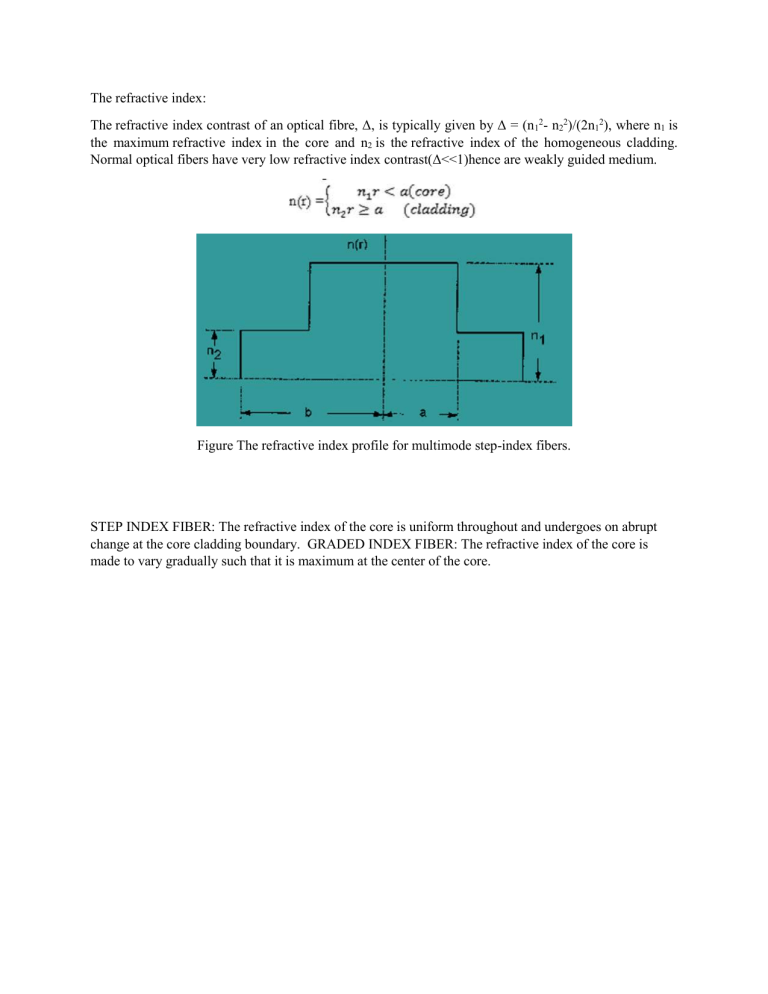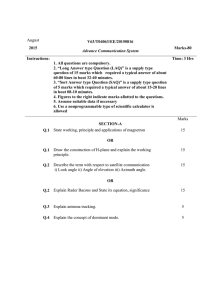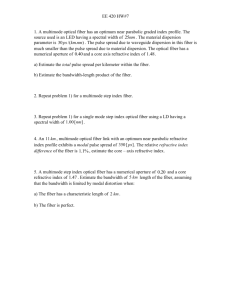Optical Fiber Lecture Notes: Refractive Index & Fiber Types
advertisement

The refractive index: The refractive index contrast of an optical fibre, Δ, is typically given by Δ = (n12- n22)/(2n12), where n1 is the maximum refractive index in the core and n2 is the refractive index of the homogeneous cladding. Normal optical fibers have very low refractive index contrast(Δ<<1)hence are weakly guided medium. Figure The refractive index profile for multimode step-index fibers. STEP INDEX FIBER: The refractive index of the core is uniform throughout and undergoes on abrupt change at the core cladding boundary. GRADED INDEX FIBER: The refractive index of the core is made to vary gradually such that it is maximum at the center of the core. Difference between Step Index fiber and Graded Index fiber STEP INDEX FIBER 1. The refractive index of the core is uniform throughout and undergoes on abrupt change at the core cladding boundary or, Light injected into the fiber optic core and striking the core-to-cladding interface at an angle greater than the critical angle is reflected back into the core. Fibers for which the refractive index of the core is a constant and the index changes abruptly at the core-cladding interface are called stepindex fibers. 2. The diameter of the core is about 50-200μm in the case of multimode fiber and 10μm in the case of single mode fiber 3. The path of light propagation is zig- zag in manner 3. Attenuation is more for multimode step index fiber but for single mode it is very less. Explanation: When a ray travels through the longer distances there will be some difference in reflected angles. Hence high angle rays arrive later than low angle rays causing dispersion resulting in distorted output. 4. This fiber has lower bandwidth 5. The light ray propagation is in the form of meridional rays and it passes through the fiber axis. GRADED INDEX FIBER 1. The refractive index of the core is made to vary gradually such that it is maximum at the center of the core. 2. The diameter of the core is about 50μm in the case of multimode fiber 3. The path of light is helical in manner 3. Attenuation is less. Explanation: Here the light rays travel with different velocity in n different paths because of their variation in their refractive indices. At the outer edge it travels faster than near the center. But almost all the rays reach the exit at the same time due to helical path. Thus, there is no dispersion. 4. This fiber has higher bandwidth 5. The light propagation is in the form of skew rays and it will not cross fiber axis. The Numerical Aperture (NA) of a fiber is defined as the sine of the largest angle an incident ray can have for total internal reflectance in the core. Rays launched outside the angle specified by a fiber's NA will excite radiation modes of the fiber. A higher core index, with respect to the cladding, means larger NA. where n2 is the refractive index of the less dense medium, and n1 is the refractive index of the denser medium. Q2 (Part 1 Problems set 1) The velocity (𝑣) of light in the core of a step index fiber is 2.01x10^8 m/s, and the critical angle (𝜃𝑐 ) at the core–cladding interface is 80°. Determine the numerical aperture and the acceptance angle (𝜃𝑎 ) for the fiber in air, assuming it has a core diameter suitable for consideration by ray analysis. The velocity of light in a vacuum is 2.998x10^8 m/s. Sol: while NA=√𝑛12 − 𝑛22 and 𝜃𝑎 = (sin 𝑁𝐴)−1 𝑛 The sin of the critical angle sin 𝜃𝑐 = 𝑛2 , where 𝜃𝑐 = 80𝑜 , and 1 𝑛𝑐𝑜𝑟𝑒 = 𝑛1 = 𝑐 2.998 × 108 = = 1.4915 𝑣 2.01 × 108 Then 𝑛2 = 𝑠𝑖𝑛𝜃𝑐 𝑛1 Finely, 𝜃𝑎 = (sin 𝑁𝐴)−1 Q3 (Part 1 Problems set 1) Define the relative refractive index difference for an optical fiber and show how it may be related to the numerical aperture. A step index fiber with a large core diameter compared with the wavelength of the transmitted light has an acceptance angle in air of 22° and a relative refractive index difference of 3%. Estimate the numerical aperture and the critical angle at the core–cladding interface for the fiber. Sol: The requested parameters are NA and 𝜃𝑐 , and the available parameters are ∆ 𝑎𝑛𝑑 𝜃𝑎 . 𝑁𝐴 = 𝑠𝑖𝑛𝜃𝑎 = sin 22 = 0.374 ∆= 𝑛1 − 𝑛2 𝑛2 𝑛2 𝑛2 =1− → = 1 − ∆ , 𝑤ℎ𝑖𝑙𝑒 ∆= 3% = 0.03, 𝑡ℎ𝑒𝑛 = 1 − 0.03 = 0.97 𝑛1 𝑛1 𝑛1 𝑛1 Finely, we can find 𝑠𝑖𝑛𝜃𝑐 = 𝑛2 , 𝑠𝑜, 𝜃𝑐 𝑛1 = 𝑠𝑖𝑛−1 𝑛2 𝑛1 Q4 (Part 1 Problem set 1) Q5 (Part 1 Problem set 1) leave it now. 6 Describe with the aid of simple ray diagrams: from problem set 1. In step index fiber, the refractive index of core is uniform throughout and undergoes an abrupt change (step change) at the core cladding interface. Depending upon number of modes propagated by the fiber we have single mode and multimode step index fibers. (a) the multimode step index fiber; MULTIMODE STEP-INDEX FIBERS A multimode step-index fiber has a core of radius (a) and a constant refractive index n1. A cladding of slightly lower refractive index n2 surrounds the core. Figure 3-2 shows the refractive index profile n(r) for this type of fiber. n(r) is equal to n1 at radial distances r &lt; a (core). n(r) is equal to n2 at radial distances r &ge; a (cladding). Notice the step decrease in the value of refractive index at the corecladding interface. This step decrease occurs at a radius equal to distance (a). The difference in the core and cladding refractive index is the parameter &Delta: Delta; is the relative refractive index difference. The ability of the fiber to accept optical energy from a light source is related to &Delta;. &Delta; also relates to the numerical aperture by The number of modes that multimode step-index fibers propagate depends on &Delta; and core radius (a) of the fiber. The number of propagating modes also depends on the wavelength (&lambda;) of the transmitted light. In a typical multimode step-index fiber, there are hundreds of propagating modes. Most modes in multimode step-index fibers propagate far from cutoff. Modes that are cut off cease to be bound to the core of the fiber. Modes that are farther away from the cutoff wavelength concentrate most of their light energy into the fiber core. Modes that propagate close to cutoff have a greater percentage of their light energy propagate in the cladding. Since most modes propagate far from cutoff, the majority of light propagates in the fiber core. Therefore, in multimode step-index fibers, cladding properties, such as cladding diameter, have limited effect on mode (light) propagation. Multimode step-index fibers have relatively large core diameters and large numerical apertures. A large core size and a large numerical aperture make it easier to couple light from a light-emitting diode (LED) into the fiber. Multimode step-index fiber core size is typically 50 &mu;m or 100 &mu;m. Unfortunately, multimode step-index fibers have limited bandwidth capabilities. Dispersion, mainly modal dispersion, limits the bandwidth or information-carrying capacity of the fiber. System designers consider each factor when selecting an appropriate fiber for each particular application. Multimode step-index fiber selection depends on system application and design. Short-haul, limited bandwidth, low-cost applications typically use multimode step-index fibers. (b) the single-mode step index fiber. Single mode step index fiber. A single mode or monomode step index fiber allows the propagation of only one traverse electromagnetic mode and hence the core diameter must be of the order of 2 µm to 10µm. It has high information carrying capacity. The single mode step index fiber has the distinct advantage of low intermodal dispersion, as only one mode is transmitted. It can be used for long distance communication It requires highly directional source such as LASER diode because of small core diameter, hence the cost is higher than multimode step index fiber. Compare the advantages and disadvantages of these two types of fiber for use as an optical channel. Advantages and Disadvantages of Single-Mode Cable Single-mode cable is more expensive to produce and operate than multimode cable, but it is much faster. The lasers that single-mode cables require are very expensive, and can only be used with one cable at a time. This dependency on lasers means that single-mode cable is less versatile than multimode, and is limited in its applications. However, single-mode cable is capable of transmitting data at up to 40GB over hundreds of kilometers with little integrity loss. Over greater distances, into the thousands of kilometers, this type of cable can send data at speeds of up to 10GB. Advantages and Disadvantages of Multimode Cable Multimode cables are less expensive to operate, install and maintain than single-mode cables. However, they are much more limited in both speed and distance. For instance, the maximum speed of a multimode cable is 10GB, but only up to a distance of 300 meters. Up to 2 kilometers, it is only capable of transmitting at 100Mbit. Beyond that, its transfer speed becomes negligible. This limitation is negated by the fact that its maximum speed is sufficient for the environment that it is most often used in. Q7: Part 1-problem set 1. A multimode step index fiber has a relative refractive index difference of 1%, and a core refractive index of 1.5. The number of modes propagating at a wavelength of 1.3um is 1100. Estimate the diameter of fiber core Solution: Given: Relative index difference, Δ= 1.0% = 0.01 Wavelength, λ = 1.3 µm Core refractive index, n1 = 1.5 Number of modes, M =1100 diameter of fiber core, d = ? The total number of modes in a multimode fiber is given by Sol: Given: Relative index difference, Δ= 1.0% = 0.01 Wavelength, λ = 1.3 μm Core refractive index, n1 = 1.5 Number of modes, M =1100 Requested: diameter of fiber core, d = ? The total number of modes in a multimode fiber is given by 2 𝜋𝑑 𝑀 = 0.5 × ( 𝑁𝐴) 𝜆 Where, d is core diameter 𝑑= 𝜆√2𝑀 𝜋𝑁𝐴 𝑁𝐴 = 𝑛1 (2∆)0.5 = 1.5 × (2 × 0.01) = 0.21213 𝑑= 1.3 × 10−6 √2 × 1100 = 91.5 × 10−6 𝑚 𝜋 × 0.21213





